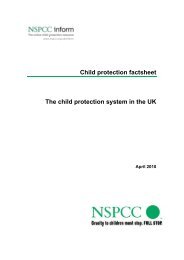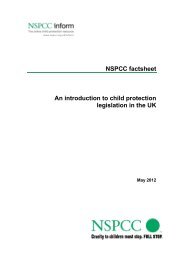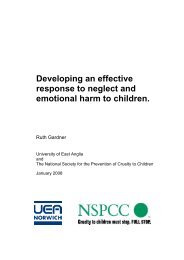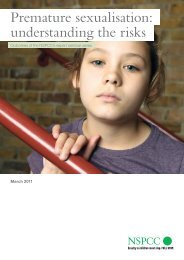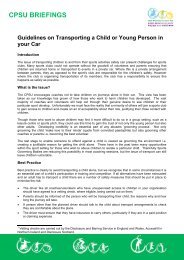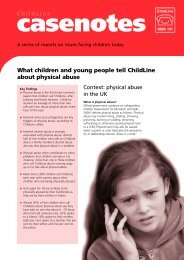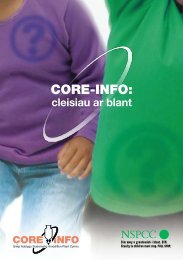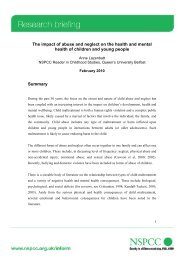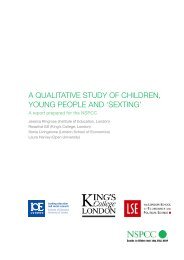Neglect and serious case reviews (PDF, 735KB) - nspcc
Neglect and serious case reviews (PDF, 735KB) - nspcc
Neglect and serious case reviews (PDF, 735KB) - nspcc
You also want an ePaper? Increase the reach of your titles
YUMPU automatically turns print PDFs into web optimized ePapers that Google loves.
iNtroductioN<br />
Key fiNdiNgS<br />
Executive Summary<br />
This study provides a new contribution to our learning about neglect by exploring the<br />
circumstances in which neglect can be catastrophic <strong>and</strong> have a fatal or <strong>serious</strong>ly harmful<br />
outcome for a child. It provides a systematic analysis of neglect in <strong>serious</strong> <strong>case</strong> <strong>reviews</strong><br />
(local multi-agency <strong>reviews</strong> of child deaths or <strong>serious</strong> injury where abuse or neglect is<br />
known or suspected) in Engl<strong>and</strong>, between 2003–2011. It draws on anonymised research<br />
information from over 800 <strong>case</strong>s from the four government commissioned national<br />
biennial analyses carried out by the authors, offering further analysis of the neglect<br />
<strong>case</strong>s that formed part of the most recent biennial analysis (Br<strong>and</strong>on et al 2012).<br />
While this examination of neglect in <strong>serious</strong> <strong>case</strong> <strong>reviews</strong> provides important new<br />
learning, it is essential to be clear about the limitations of the study. Serious <strong>case</strong><br />
<strong>reviews</strong> are not a reflection of typical child protection practice. The constellation of<br />
neglect-related events <strong>and</strong> characteristics that came together in these <strong>case</strong>s to produce<br />
an outcome of fatality or grave injury cannot be distilled into a check list of risk factors<br />
that predict such an outcome. In most <strong>case</strong>s with similar characteristics, a child will<br />
not come to such catastrophic harm. Yet there is learning here about how risks of harm<br />
accumulate <strong>and</strong> combine <strong>and</strong> the points at which intervention might successfully<br />
have helped to contain these risks. The learning is as important for children known to<br />
universal services, where they do not see a social worker, as for children with known<br />
child protection risks.<br />
• <strong>Neglect</strong> is much more prevalent in <strong>serious</strong> <strong>case</strong> <strong>reviews</strong> than had previously been<br />
understood (we found neglect in 60 per cent of the 139 <strong>reviews</strong> from 2009–2011).<br />
• <strong>Neglect</strong> can be life threatening <strong>and</strong> needs to be treated with as much urgency as other<br />
categories of maltreatment.<br />
• <strong>Neglect</strong> with the most <strong>serious</strong> outcomes is not confined to the youngest children, <strong>and</strong><br />
occurs across all ages.<br />
7




